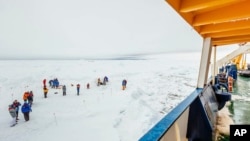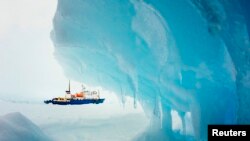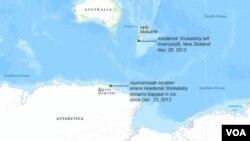An Antarctic blizzard has halted an Australian icebreaker's attempt to retrieve 74 people on board a Russian research ship.
The ship has been trapped for nearly a week in ice, while high winds prevent a helicopter rescue. The Australian Maritime Safety Authority, which is coordinating the rescue, said Monday that the icebreaker Aurora Australis had to return to open waters because of poor visibility.
A Chinese icebreaker, Snow Dragon, was sent to free the vessel and came within 11 kilometers of the stranded Russian ship on Saturday, but had to stop when thick ice blocked its progress.
If the Australian vessel fails to break through the 3-meter-thick ice, a helicopter on the Chinese ship could be used to evacuate the passengers on the trapped vessel. But the storm has grounded the helicopter for the time being.
The Russian ship is carrying 74 people, including an Australian research expedition, tourists and crew members. The ship became frozen in an ice flow near the South Pole on Tuesday. Officials say the vessel is not in danger of sinking.
In a video posted on Twitter Saturday, members of the Australian research team said they could see the Snow Dragon on the horizon.
The Russian ship, which left New Zealand on November 28, was trying to recreate Australian explorer Douglas Mawson's century-old voyage to Antarctica.
The ship has been trapped for nearly a week in ice, while high winds prevent a helicopter rescue. The Australian Maritime Safety Authority, which is coordinating the rescue, said Monday that the icebreaker Aurora Australis had to return to open waters because of poor visibility.
A Chinese icebreaker, Snow Dragon, was sent to free the vessel and came within 11 kilometers of the stranded Russian ship on Saturday, but had to stop when thick ice blocked its progress.
If the Australian vessel fails to break through the 3-meter-thick ice, a helicopter on the Chinese ship could be used to evacuate the passengers on the trapped vessel. But the storm has grounded the helicopter for the time being.
The Russian ship is carrying 74 people, including an Australian research expedition, tourists and crew members. The ship became frozen in an ice flow near the South Pole on Tuesday. Officials say the vessel is not in danger of sinking.
In a video posted on Twitter Saturday, members of the Australian research team said they could see the Snow Dragon on the horizon.
The Russian ship, which left New Zealand on November 28, was trying to recreate Australian explorer Douglas Mawson's century-old voyage to Antarctica.












